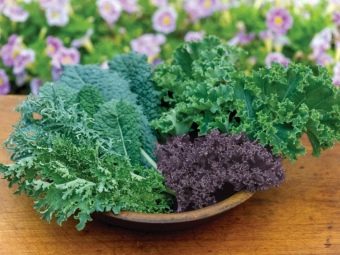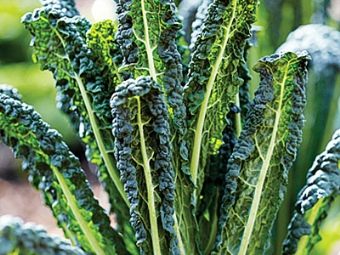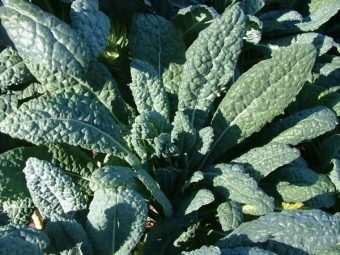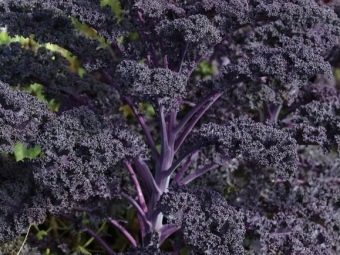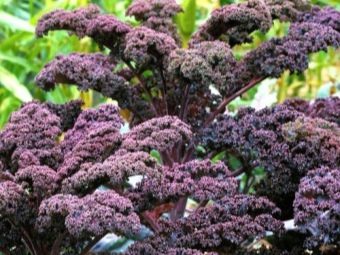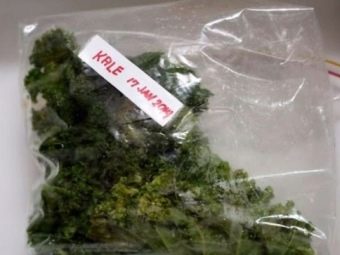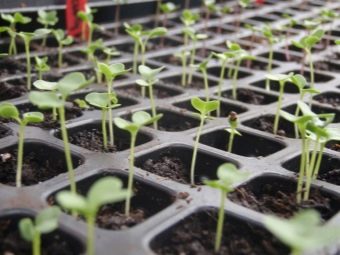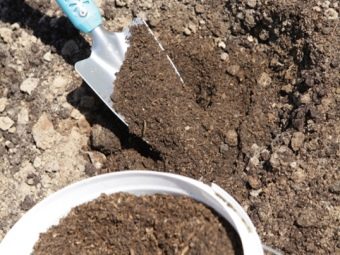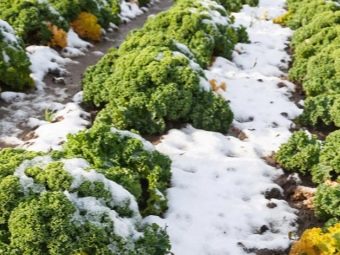Cabbage "Kale": varieties and fineness of planting
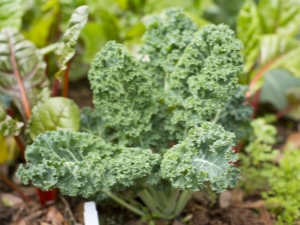
Each owner, growing vegetables on his plot, wants to get a green crop as a result.Cabbage is considered one of the most popular vegetables: both white and cauliflower.
However, many people forget about this kind of cabbage, like "Kale". It is not only rich in vitamins, but also develops well in our area.
What it is?
This type of cabbage takes the first place in the content of useful substances, and for this reason the vegetable attracts the attention of all gardeners. In addition to the rich composition, it is also pleasing that it is unpretentious in the care.
Cabbage "Kale" - leaf culture. It belongs to the Cruciferous family. Very often it is called completely different. For example, "Braunkol", "Cale" or even curly cabbage. The Kale variety differs from the usual cabbage in that it does not form a head, but has very beautiful curly leaves.
"Kale" is an annual plant that has a shortened stem. On it the leaves are located in several tiers. They are pretty curly, and the edges resemble the waves in appearance. For eating, use only the leaves, the stem before cooking is separated.
Such cabbage differs in various color scale: it can be green, red and even violet. Color depends on the type of plant. For this reason, it can be seen in many flower beds and flower gardens - cabbage will become a real decoration of the garden or yard.
Such cabbage has a high yield, and this is important in its description. After cutting off part of the leaves, it still bears fruit.
Appreciate "Kale" not only for beauty - its main advantage is the composition enriched with useful elements. When eaten, it nourishes the body with nutrients and vitamins.
Sorta
Cabbage "Kale" has many varieties. Among them are both stunted and tall varieties. Among other things, there are early-ripening and late-ripening types of this vegetable. It is necessary to consider the most popular and well-proven varieties of cabbage "Kale".
"Black Tuscany"
This type of cabbage consists of basal leaves having malachite color and gray outflow. This vegetable grows in a warm climate. Harvesting begins two months after the first shoots appeared, and ends with the onset of frost.
Green Dwarf
This cabbage has a height of up to 40 centimeters. Her leaves are pale green. The structure resembles a salad. This is an early ripe variety resistant to cold.
"Dino"
This variety is a bit like "Tuscany". He also has excellent taste and beneficial properties. Harvest can be harvested to the cold.
"Reflex F1"
This cabbage grows in height to 90 centimeters. Corrugated leaves are colored green, which are also pleasant to the taste. She is not afraid of cold weather, is considered mid-season variety. Harvest can be collected until the cold.
Redbor F1
Among all types of cabbage, this hybrid stands out in particular. It has terry leaves of a gentle-violet shade. Such cabbage is quite pleasant to the taste. Externally, it is very similar to a palm tree, growing in height to one meter. Cabbage has high yields, and is not afraid of the cold.
"Siberian"
This variety is not afraid of even severe frosts, does not require special care. It has flat green leaves, resembling plates and having edges with teeth. This variety is almost not subjected to attacks of pests.
"Red Russian F1"
This mid-season variety has proven itself. It grows in height to 80 centimeters, wavy leaves are painted in light green color and have a carved border. This is a very hardy variety of cabbage, having a sweetish taste.
Beneficial features
Cabbage "Kale" brings a lot of benefit to the human body and virtually no harm.
- It ranks first among plant products in the number of protein substances in it. It also contains up to 25 amino acids, and the leaves are rich in fatty acid, the amount of which is almost the same as in the composition of fish products.Therefore, many vegetarians call it vegan beef.
- Since this product is growing very rapidly, it is considered the earliest vitamin harvest. You can eat curly cabbage at the beginning of summer. It is just very distinguishes it from other varieties.
- Since Russian cuisine is known for many cabbage dishes, this product is actively used in the preparation of traditional delicacies. It replaces the whitish duck that has become boring to many.
- The daily use of cabbage "Kale" will save your eyes from ultraviolet rays.
- Trace elements that are in it, perfectly remove all toxins and radionuclides from the body in a short time.
- But calcium, zinc and phosphorus, its constituent, inhibit the development of cancer. So, one gram of cabbage contains 1.3 ml of calcium, which is quite a lot for a simple vegetable.
- Cabbage is easily absorbed by the body and ensures its vital activity.
- This vegetable is highly appreciated by nutritionists, because only 100 kilocalories per 100 grams of green leaves. Therefore, this product is in first place in popularity among those who are in the process of losing weight. Very often, it is used to make smoothies, because Kale cabbage goes well with many products: both with greens, and with vegetables or even fruits.
- The leaves are most often used fresh, but you can also add them to vegetable stews and make them into filling for pies. You can make preparations for the winter: dry and namorozit cabbage, and then cook different vegetables from semi-finished products. As well as from usual cabbage, from "Kale" it is possible to make salting for the winter.
- Leaves in the fridge can be kept fresh for about a week. Therefore, you can not be afraid to cut off a lot of greenery at once.
However, like any other plant, this type of cabbage has some drawbacks. First of all, it is worth noting that not everyone can eat cabbage leaves as food.
It is strictly contraindicated for people suffering from intolerance to this product. Also, it can not be for those with acute kidney disease, as it contains a large amount of oxalic acid.
How to plant?
Planting cabbage "Kale" can be both in open ground and seedling method. To determine which method will be best, you need to consider each of them in more detail.
With the help of seedlings
In order for the harvest to be of high quality and early, it is necessary to sow the seeds not earlier than 50 days before the seedlings are planted in open ground. First you need to fill the tank with good soil. For this fit special containers with individual cups.
Seeds should be planted no more than 1 centimeter to the ground, 2 or 3 seeds in each cup. If you immerse the seeds deeper, the seedlings may not appear for a long time. So that they appear on time and together, it is also necessary to keep the temperature in the room at 24 degrees. Before emergence of shoots, the container is covered with a transparent film.
As soon as the seedlings rise, the temperature can be gradually reduced to 17 degrees. However, the lighting should be good at all stages of growth. After germination in each cell you need to leave one germ. To do this, choose the strongest escape.
After 6 weeks, you can prepare seedlings for planting in open ground. During this time, it will become similar to the picture on the package with seeds: the leaves will become curly, and the plant will grow. Seedlings need to be transplanted carefully enough not to damage its roots in any way, because it takes root very badly.
Sowing in the ground
Deciding to sow cabbage seeds directly into the ground, first of all, it is necessary to choose fertile land. It can be placed in those areas where cucumbers or tomatoes were planted, as well as potatoes. Land needs to be prepared in the fall. To do this, add humus in the following proportions: per 1 square meter 3 kilograms of compost.
It is better to plant cabbage seeds in an open area, but a little shade does not hurt.Sowing begins in April-May, but you need to make sure that the earth warms to 5-6 degrees Celsius. In the cold or frozen ground to plant sprouts just can not.
The wells for sowing seeds must be placed at a distance of at least 40 centimeters from each other. Just as in seedlings, seeds should be immersed no more than 1 centimeter in the ground, 2–3 pieces each. Then they must be watered and covered with a transparent film. But this is only for 4 days, since the seedlings will need a lot of light for normal development.
Cultivation and care
In order for Kale cabbage to grow well, it is necessary to grow and care for it properly.
Growing up
To grow seeds "Kale", you do not need special knowledge. Everything is done in almost the same way as with ordinary white cabbage. But if the second can be grown only in the garden, then the first one will look great in flowerbeds: its curly leaves will look great both themselves and surrounded by other flowers. A very important quality is the stability of cabbage "Kale" to the cold. It can withstand frosts up to 60 degrees, while not losing its beneficial properties.
Growing seedlings, it is imperative to regularly water it. However, do not be too zealous not to overwet the ground. This may cause the seedlings to marvel at the blackleg disease. It is also necessary to illuminate the seedlings at night using fluorescent light bulbs for more rapid growth of seedlings.
In order to develop it better, you need to do top dressing twice during the entire growth of the seedlings. This process is carried out on day 14 after sprouting and 2 weeks after that. Do not forget about hardening seedlings. This should begin to do about a week after germination.
With the onset of good weather conditions, seedlings need to start preparing for planting. This is done in early May. And if the weather conditions allow, then you can disembark in April.
Care
Like any cabbage, “Kale” is a rather moisture-loving plant. And for this it is necessary to do watering so that the soil is in a moist state all the time. You need to water both at the root and at the plant itself. It is better to do this with a watering can, so that the moisture is evenly distributed, and with water heated in the sun. However, as mentioned above, too much zeal is not necessary.
After each watering the land should be loosened and spud cabbage bush itself. It is also necessary to fight weeds.
To facilitate care, you can cover the ground under cabbage with straw or sawdust. This will significantly reduce the watering of plants and save the owners from daily weeding. Mulching also does not allow weeds to grow.
For lush leaves, cabbage must often be fertilized. Do it three times per season. The first feeding is carried out 15 days after planting the seedlings in open ground. To do this, fit a solution of urea in a ratio of 1 tablespoon of fertilizer to 10 liters of water.
The second feeding is done 3 weeks after the first. You need to do it with the help of a mullein. The proportion of dilution is 1 liter of feed per 10 liters of water. The third dressing can be done in a month. To do this, you need a solution of nitroammofoski. The proportions are the same as for urea.
All fertilizers must be poured under the root of the plant. Under each bush you need to pour 1 liter of the solution. Do not overdo it, as this may lead to the fact that the plant will turn yellow. In addition, all fertilizers, of course, must be of very high quality.
Already 2 or 3 months after the shoots appeared, “Kale” begins to bear fruit. Cutting time depends directly on the plant variety. When the height is already 20 centimeters, you can try the first leaves, which will be very tasty and tender.
It is better to cut cabbage early in the morning, when the leaves are sufficiently moist.
Useful recommendations
This vegetable affects the same diseases as ordinary cabbage.If there are any signs of fungal diseases such as powdery mildew, white or gray rot and many other diseases, then the bush must be treated with a fungicide. To do this, you can buy "Hom" or similar drugs. If between them there are too neglected plants, then it is better to remove them completely.
Kale can also be harmed by insects such as the cabbage fly or weevil, whitefish caterpillars or cabbage moths. In order not to use such harmful insecticides as "Decis" or "Actofit", you can try to get rid of them with the help of folk remedies.
For this fit tincture of onion peel or wormwood. You can sprinkle the plant with wood ash or tobacco dust. You can also plant plants such as mint, saffron or even ordinary marigolds nearby. They will not only please the eye, but also deter some pests. In addition, mint and saffron can be used to create culinary masterpieces.
Do not forget about the maintenance work: be sure to remove the rotten and withered leaves, do not allow the land to dry out.
This vegetable variety receives excellent reviews from those who have tried it and grown it on its site. People are attracted to the taste of the vegetable, its beautiful appearance and vitamin composition. And ease of care does not leave indifferent any summer resident.
Cabbage "Kale" is not so common in our regions. However, recently its cultivation is gaining popularity, because thanks to its useful qualities, it is useful for almost every person. Grow it will not be difficult. To do this, you need to study a little the details of its planting and growing. And then this product will delight the owners with its rich vitamins all year round.
The fact that cabbage "Kale" is useful, how to choose it and properly cook it, see the next video.






